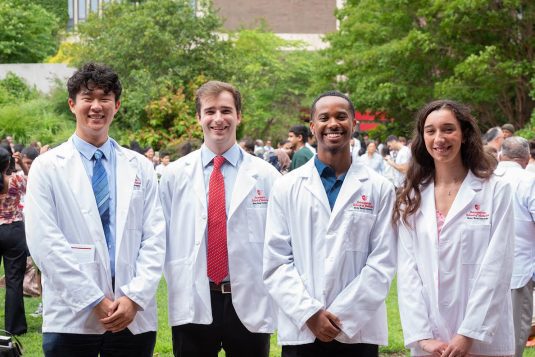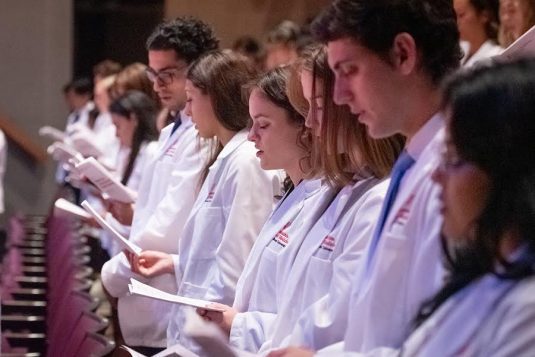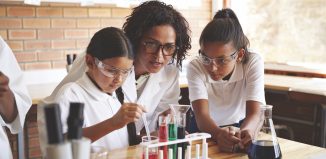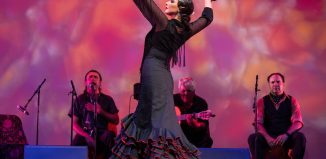White Coat Ceremony welcomes future MDs to the Renaissance School of Medicine at SBU
Family experiences, commitment to service, intrigue with biotech advances, drive many of the new 136 RSOM students to pursue medicine
At the Renaissance School of Medicine’s (RSOM) White Coat Ceremony, 136 incoming students officially began their medical school training by taking the Hippocratic Oath and wearing their physician “white coats” for the first time. Held at Stony Brook University’s Staller Center on August 9, the annual ceremony brings students, their families, and faculty together as the academic year begins. The RSOM has held a White Coat Ceremony since 1998.
The incoming Class of 2028 is a highly select group, as only eight percent of all applicants to the RSOM for this academic year were accepted into the program. Collectively, the students received their undergraduate degrees from 57 different colleges and universities around the nation. Stony Brook University had the most representation, as 33 students earned their undergraduate degrees at Stony Brook. While a good portion of the students are from around the country, nearly 75 percent are from New York State.
Peter Igarashi, MD, Knapp Dean of the RSOM, congratulated the incoming class and told the students they are entering the field at a time when the practice of medicine is rapidly evolving and where discoveries to diagnose and treat disease are advancing and newer practices such as telemedicine are becoming commonplace. He emphasized the RSOM’s commitment to science-based medicine, and also urged the students to place the heart of their work around patients, as the practice of medicine is best with a “focus on a strong doctor/patient relationship.”
While the students’ paths into medicine and reasons for choosing the profession are varied, their experiences with family members who suffered from diseases, interest in service to people, and intrigue with advances in biotechnology, appeared to be some common factors for pursuing medicine.
New student stories
Gabriel Chan, a Long Island native, says that a turning point for him when deciding to pursue medicine was when his grandfather was diagnosed with Parkinson’s disease. He has entered the RSOM’s Medical Scientist Training Program, or MD/PhD program. Chan starts medical school fresh from a Fulbright Scholar experience in France where he conducted computational neuroscience research at Centre Borelli in Paris.
Reinaldo Powell, graduated in 2024 from Stony Brook with a Bachelor’s Degree in Health Sciences. He was eager to enter medicine and felt at home with the RSOM and its approach to education.
“I was always enamored by the role a physician can play in improving the lives of their patients. This was further exacerbated when I lost my mother to lymphoma when I was 14, and this inspired me to pursue a career to help those who hurt and one that looks to understand the specifics behind disease,” says Powell.
Two of the new med students are using their experience in the military as an inspiration and catalyst toward entering medicine.
Juan Diego Carvajal Ramirez, who most recently lived in California, spent time in the U.S. Army as a combat medic. That training sparked his interest in trauma medicine, and he hopes to ultimately specialize in trauma surgery. Additionally, he chose the RSOM because during a conversation with a current fourth-year medical student in the interview process he learned how much hands-on training and mentorship the RSOM faculty provides, something he sees as essential for trauma and emergency training.
Another Stony Brook University graduate and U.S. Army Second Lieutenant, Pamela Chen, found that all of her army training drills, including combat medic training, fit her pursuit of medicine given the discipline the work requires and its focus on teamwork and caring for soldiers.
Chen’s experience of losing her father at a young age due to Parkinson’s disease, her life in the New York City foster care system, and eventually growing up with a permanent family in Bethpage, NY, made her sensitive to the needs of people and families, especially when family members are ill.
Emily Cahill, who hails from Rockland County, NY, worked at Regeneron Pharmaceuticals in a cell culture lab producing therapeutic antibody candidates for drug development. While she enjoyed the science and laboratory work, it was a program she was involved as an undergraduate at Johns Hopkins University designed to improve communication between patients and their caregivers that drove her interest in patient care and people’s stories themselves, not just their illnesses.
Cahill is interested in caring for children. She is enrolled in the RSOM’s three-year MD program and will continue on in a Pediatric Residency position at Stony Brook Medicine after graduation.
Another student, Massachusetts native Henry Wilmot, recently worked in the biotech/pharmaceutical industry in Manhattan in a consulting capacity where he collaborated with clients to support commercialization for products geared to treat rare diseases. Working in biotechnology, he says, was fascinating and had impact but he also felt a disconnect.
Wilmot comes from a family of service professionals including a social worker, paramedic and pediatrician. He felt moved to add this aspect to his career path.
“I knew that I wanted to interact at the human level with patients and bring my experience from the business side of healthcare into the clinic to advocate for patients seeking complex therapeutics.”
Captions:
The Renaissance School of Medicine (RSOM) welcomed the incoming Class of 2028 in August. Set for their medical school training are, from left, students Gabriel Chan, Henry Wilmot, Reinaldo Powell, and Emily Cahill.
The 136 students comprising the incoming Class recite the Hippocratic Oath for the first time.
Photo Credit:
Arthur Fredericks








